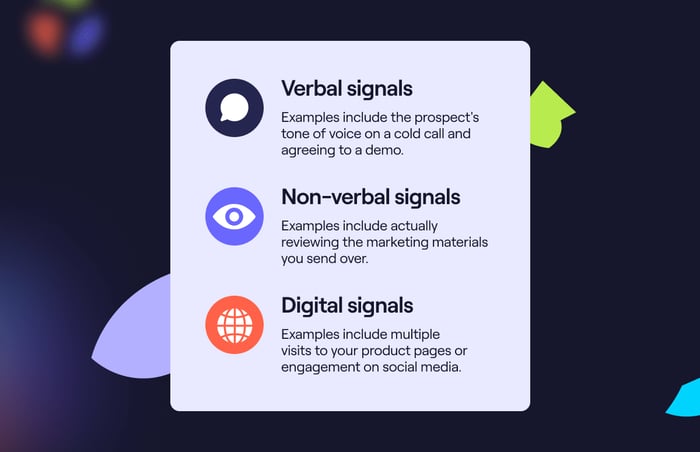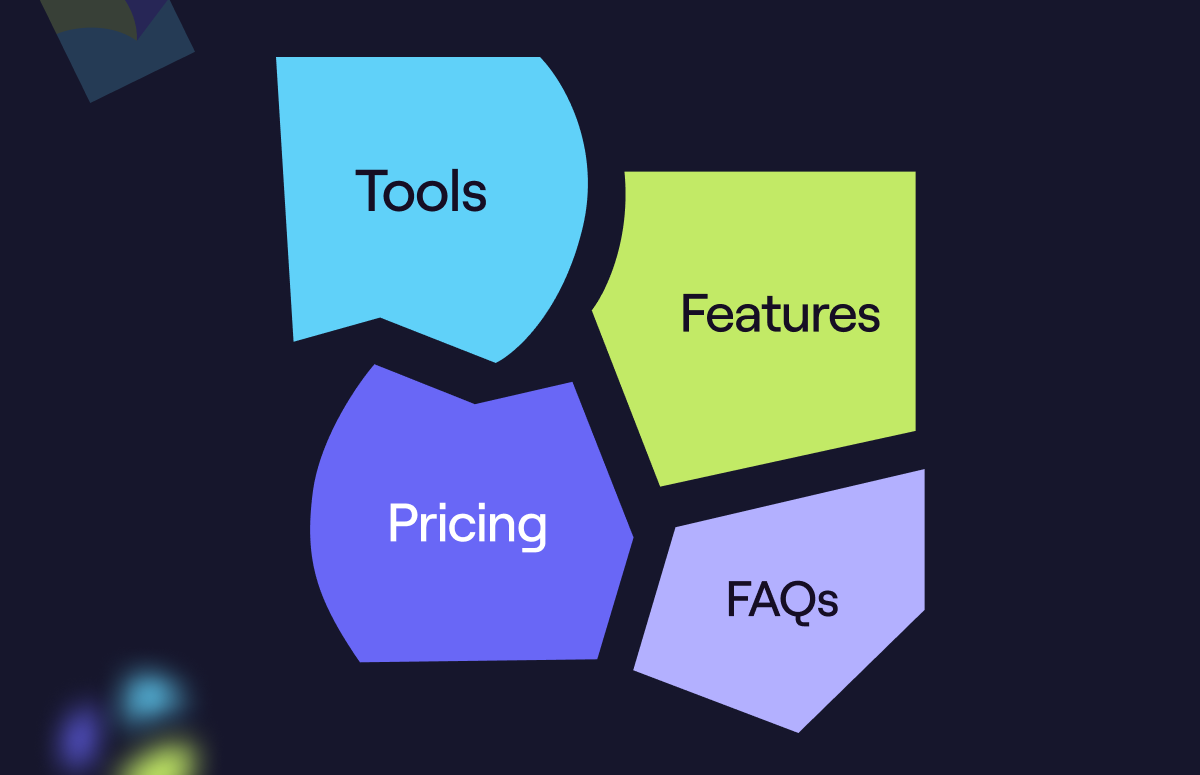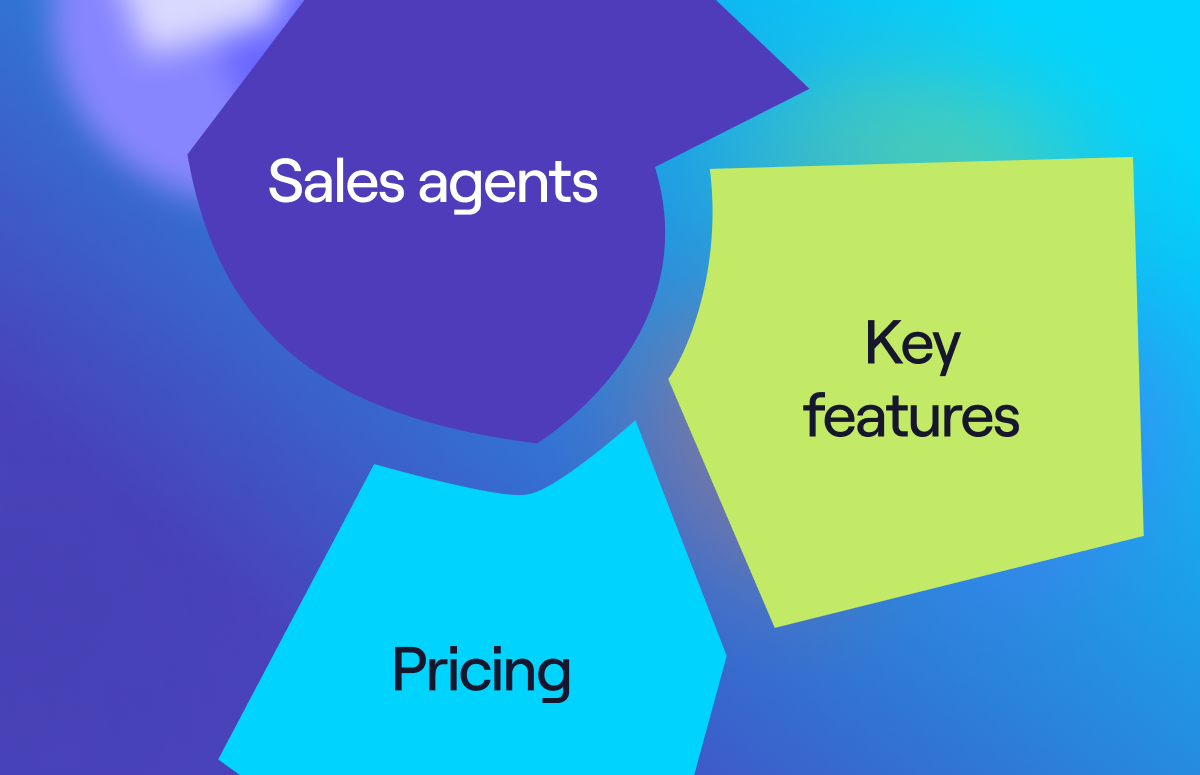13 Buying Signals & How Strong They Are [Guide]
What's on this page:
Buying signals are arguably harder to track in this digital age, or are they?
A “buying signal” is an action or behaviour a potential customer takes that suggests they’re interested in purchasing your product or service, such as signing up for a demo or free trial.
They’re a core part of the SaaS sales process, but some are more valuable than others.
Let’s explore the benefits of recognising and acting on these signals and how high-performing marketing and sales teams approach them.
Types of buying signals
Studies have shown that prospects wait until they’re 57-70% of the way through researching a product before speaking to sales. This is where buying signals come in.
There are different types of signs someone is in-market (or might soon be) to buy, which are split out into three different categories: verbal signals, non-verbal signals and digital signals.

Verbal signals
Verbal signals happen with prospects either during a cold call or if you meet in person. The tone of voice while on a cold call, for example, indicates someone’s interest. Another is simply if they say they are interested (or not…).
Non-verbal signals
Non-verbal buying signals are much harder to pick up on, particularly on a Zoom call. It’s also why salespeople need good interpersonal skills. Non-verbal cues might include positive body language such as nodding to what’s being said, actually reviewing the marketing materials you send, and taking notes while on your demo.
Digital signals
Digital signals present a new way to track educated buyers. These signals could be multiple visits to your product or pricing pages, engagement with your brand on social media, or joining your gated community.
There’s also a way to find other digital signals, like high-intent searches for your company, job changes, and funding rounds; enter Cognism Sales Companion. Your +1 for prospecting, Sales Companion helps sellers to surface the intelligence they need to target specific accounts.
How to recognise buying signals
It’s important to understand that different buying signals present themselves at various stages of the sales process. And that not all buying signals should be weighted equal.
For example, some regard content downloads as a buying signal in lead generation. However, this is an extremely low-intent activity and can often (but not always) drive bad-fit prospects. A stronger buying signal would be a demo request.
There are also less tangible buying signals that demonstrate an account could be open to buy soon. Let’s understand how good-quality data helps you find and recognise these signals. 👇
Firmographic and demographic data
Firmographic and demographic data help sellers and marketers assess ICP fit. You wouldn’t ask a fish to climb a tree, right? Well, this is the same concept… kind of. With this type of data at the go-to-market team’s fingertips, it’s much easier to create a targeted list of contacts to outreach and market to.
Surface potential opportunities
Specific types of signal data help sales reps identify prospects who could soon be in the market to buy. These include job changes, funding rounds, and technographic data.
Job changes
A job change signals that your prospect could be in the market to buy. When more leadership changes, it’s often the calling card for change. People are usually looking to make an impact, and reviewing the tech stack is a standard item on their list.
Funding rounds
New funding indicates that your target account has more to spend. When new funding is agreed upon, budgets change, and more hiring occurs.
Technographic data
Ever heard of the phrase “no one ever got fired for buying IBM”? Prospects often stick with what they know. It’s what’s comfortable. But part of a rep’s job is convincing people to switch. Technographic data tells you how solution-aware your prospect is and what they currently have in their tech stack.
💡You might be interested in technographic data providers.
Intent data
Last but not least, intent data. Intent data helps reps and marketers to identify who is in the market to buy right now. It provides insights into online buying behaviours, such as who is searching for your brand name, a key indicator of a purchase decision.
13 buying signals [+their strength]
Now we’ve been through the basics, let’s get to 13 buying signals that you’ll experience during your time in B2B marketing or sales. We’ll work from the highest signal strength to the lowest.
1. Request for a trial or demo
Signal strength = High
On average, only three vendors will get a demo when a purchase decision is being made. So, if one is going to you, then congrats—you’re on the shortlist! This is why booking a demo is such a strong buying signal. The target account is problem—and solution-aware, and they’re in the market to do something about it.
At this point, account executives and sales reps must collaborate to personalise the demo according to the prospect’s needs.
2. Direct enquires about pricing
Signal strength = High
Requesting to see more pricing information is another high-intent signal. Some vendors don’t display pricing directly on their websites due to the custom nature of their packages.
A pricing request is another key indicator that you’re on a vendor shortlist or alternatives are being considered. In addition to pricing, the prospect may have questions about the platform, so sometimes, these requests run similarly to demos.
3. Request for proposals (RFP) submission
Signal strength = High
A request for proposals (RFP) submission shows that your prospect is in the market to buy very soon. RFPs are open requests for bids to complete a new project for the company or organisation that issues it. The idea behind them is to open up tech implementations to the competition to receive alternative proposals that might not have been considered internally.
Okay, so maybe the account isn’t knocking at your door just yet, but this is such a strong signal of their intent to buy (and potentially from you) that it’s not a sign to ignore.
4. Engaged interaction with a sales rep
Signal strength = High
So picture this: You’re a sales rep, and you’ve got a prospect in your cadence. You’ve just given them a dial, and they’ve agreed to a demo. This is a strong signal that they’re open to change. Maybe they’ve already got a solution in place that just isn’t being used widely within the team. Or did your competitor’s pricing just go up?
Either way, it’s clear that engaged interactions likely mean that a prospect is interested. We’re not just talking about a prospect liking your latest LinkedIn post. Cold calling or a request to have a demo via textual channels is probably the only way to ascertain a buying signal this way.
5. Asking about product customisations or integrations
Signal strength = Medium
If a prospect asks about your integrations or tool customisations, you’re probably on their radar. You’re probably not on their shortlist yet, though. Asking about integrations implies they’re trying to identify if each tool they’re considering will fit with their existing tech stack.
Technographic data is super useful, and we’re able to know this through it. Sales Companion, for example, shows technographic data for 20,000 technologies. This means reps can identify what products your prospects are using and when these could be up for renewal.
6. Repeated visits to specific product pages
Signal strength = Medium
This signal indicates that your target account is researching solutions. But it’s important to remember not all pages point to a buying decision. For example, if someone visits your blog regularly, it is more likely that they value it as an educational source rather than being interested in buying from you.
Pages like your demo request or pricing page are a different story. If someone’s repeatably visiting these, they’re likely looking at you as a potential solution. You can use specific software to track your website visitors to certain pages, including Lead Forensics, Dealfront, and many more.
Did you know Lead Forensics already uses Cognism for sales intelligence? Here’s what their CEO says about it:

CEO @Lead Forensics

7. Leadership changes
Signal strength = Medium
Leaders typically spend 70% of their budget within the first 100 days of starting their new role. That’s why leadership changes are a key indicator of target accounts being in-market to buy. New starters also typically want to make an impact, so implementing new tech can be a quick win in addressing some of the pain points surrounding their current ways of working.
Cognism’s Sales Companion tracks champions leaving, new people joining, and individuals being promoted to maximise the relevance of your outreach.
8. Mergers & acquisitions (M&A)
Signal strength = Medium
M&As are a buying signal because leadership changes often follow them. As we’ve just discussed, this means new decision-makers are entering positions with new budgets.
9. Funding rounds
Signal strength = Medium
Companies that recently raised funding are 2.5x more likely to buy new solutions. This is an indicator that budgets are about to get bigger, including for the tech stack. Cognism’s Sales Companion tracks 12 different types of funding alerts so your reps know exactly what route to take.
10. Participation with product-specific webinars or events
Signal strength = Medium
If a prospect attends your product-specific webinars, it implies a move away from general interest to consideration. They’ve likely attended the event to gain more information and understanding about your product and how it works. This is a much stronger signal of intent to buy than if they were to attend an educational event.
11. Responding to cold outreach
Signal strength = Medium
Was that a reply!? It’s a good sign when a prospect receives your cold call positively (i.e., allows you to speak) or even replies to your email. They might not be ready to buy right now, but you’ve piqued their interest. However, cold outreach responses don’t always lead to the next step, like a demo, nurturing and building a relationship with these people is crucial.
12. Content downloads
Signal strength = Low
When content is gated, a prospect can access it only in exchange for their contact details. This signal should not be considered as a strong intent to buy because it’s likely the lead just really wants to gain access to the piece of content put behind bars. The leads passed through to sales from this lead generation method are often low quality.
While content downloads are a good way to measure the performance of specific pieces of content; they aren’t an indicator of being in-market to buy.
Pro tip: One of the reasons we switched to demand generation was to move away from content downloads and the lead gen hamster wheel.
13. Newsletter sign-ups or social media follows
Signal strength = Low
While newsletter sign-ups and social media follows are good initial engagements, it’s not time for sales to get involved. These buyer signals are lower intent and mean that the leads need nurturing. Maybe next, you’d like to introduce them to some ads from your content bucket. They just aren’t ready to learn more about your product yet.
Buying signal FAQs
Which is the biggest buying signal?
The biggest (or most strong) buying signal is the demo request. It indicates that this person has considered and shortlisted you as a potential new vendor.
How to interpret buying signals?
Different buying signals mean different things. Some are much stronger (e.g., requesting a demo), and some are weaker (e.g., a content download). Either way, for qualified leads, a buying signal is a positive thing because it demonstrates that the prospect is aware that your company exists.
Are objections buying signals?
Some salespeople say objections are buying signals, too. Arguably, because an objection conveys more interest than cold calling prospects who stay silent, hang up or just bluntly say they aren’t interested.
The final say on buying signals
Due to the complex nature of B2B selling today, buying signals are extremely helpful (and necessary) if you want to succeed.
Sure, you can find them through research online, but tools like Cognism Sales Companion make it so much easier to see all the buying signals you need for a specific target account in one place. Book your demo today to find out more.




-1.jpg)